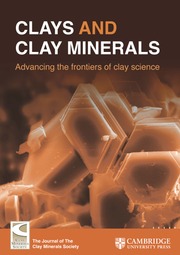Article contents
Development and Characterization of Sintered Zeolite and Zeolite-Kaolin Wick Structure for Thermosiphon Heat-Pipe Application
Published online by Cambridge University Press: 01 January 2024
Abstract
A wick structure is the core part of a heat pipe that produces capillaries to move liquid from a condenser to an evaporator. The purpose of the current study was to develop a wick structure from zeolite and kaolin using various sintering methods. Due to significant porosity and water-adsorption properties, zeolite and kaolin can produce a large capillary force inside the heat pipe. A porous wick specimen is developed from pure zeolite together with a mixture of zeolite and kaolin by using pressureless (loosely packed) and conventional pressurized sintering for thermosiphon heat-pipe applications. Major properties such as porosity, water adsorption, and permeability were noted to be better under pressureless sintering compared to pressurized sintering. Significant and uneven shrinkage in both radial and linear directions is a major problem in loosely packed sintering of pure zeolite. However, the addition of kaolin helps to overcome the problem of porosity and shrinkage in pure zeolite; but the permeability and strength of the wick structure are reduced with the addition of kaolin. A general trend is that increasing porosity causes increasing permeability. Due to grain size and compaction, however, permeability is reduced with the addition of kaolin. Based on the experimental results for porosity and permeability, the wick structure formed from zeolite with 5–10% of kaolin has better thermal properties for heat-pipe applications.
Information
- Type
- Original Paper
- Information
- Copyright
- Copyright © The Author(s), under exclusive licence to The Clay Minerals Society 2023
Footnotes
Associate Editor: Prakash Malla
References
- 1
- Cited by

